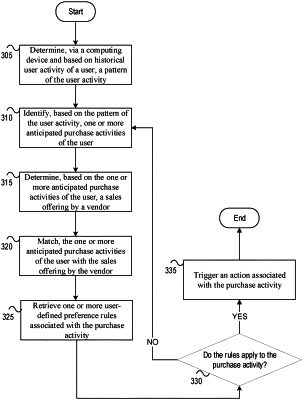| CPC G06N 5/04 (2013.01) [G06N 3/006 (2013.01); G06N 20/00 (2019.01); G06Q 30/0201 (2013.01); G06Q 30/0203 (2013.01); G06Q 30/0631 (2013.01); G06Q 30/08 (2013.01); G06Q 30/016 (2013.01); G06Q 40/03 (2023.01)] | 19 Claims |

|
1. A computing platform, comprising:
at least one processor; and
memory storing computer-readable instructions that, when executed by the at least one processor, cause the computing platform to:
initiate, via an intelligent chat bot, an interactive communication session with a user;
receive, from the user and via the intelligent chat bot, user response data;
process, using natural language processing, the user response data to determine one or more user-defined preference rules for the user;
determine, via a computing device and based on historical user activity of the user, a pattern of the user activity;
identify, based on the pattern of the user activity, one or more anticipated purchase activities of the user;
determine, via the computing device and based on the one or more anticipated purchase activities of the user, a sales offering by a vendor including a discount associated with the one or more anticipated purchase activities of the user;
match, via the computing device, the one or more anticipated purchase activities of the user with the sales offering by the vendor, wherein matching the one or more anticipated purchase activities of the user with the sales offering by the vendor further includes executing, by a machine learning model, an optimization algorithm configured to identify optimized resources;
retrieve, from a repository of user data and for a purchase activity of the one or more anticipated purchase activities, the one or more user-defined preference rules associated with the purchase activity, wherein the one or more user-defined preference rules include a distance a user is willing to travel for a product included in the one or more anticipated purchase activities of the user;
determine whether the one or more user-defined preference rules apply to one or more attributes of the purchase activity;
determine that a user-defined time period has expired;
trigger, via the computing device and based on a determination that the one or more user-defined preference rules apply to the one or more attributes of the purchase activity and based on the determining that the user-defined time period has expired, an action associated with the purchase activity;
determine whether the user is able to connect to the internet;
responsive to determining that the user is able to connect to the internet, provide communications to the user via a first mode of communication;
responsive to determining that the user is not able to connect to the internet, provide communications to the user via a second, different mode of communication; and
wherein the triggering, based on the determination that the one or more user-defined preference rules apply to the one or more attributes of purchase activity and based on the determining that the user-defined time period has expired, the action associated with the purchase activity further includes at least providing communications to the user via one of: the first mode of communication and the second mode of communication.
|